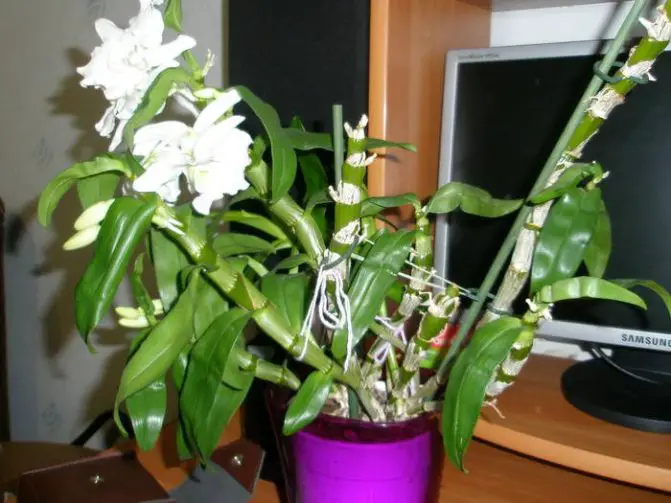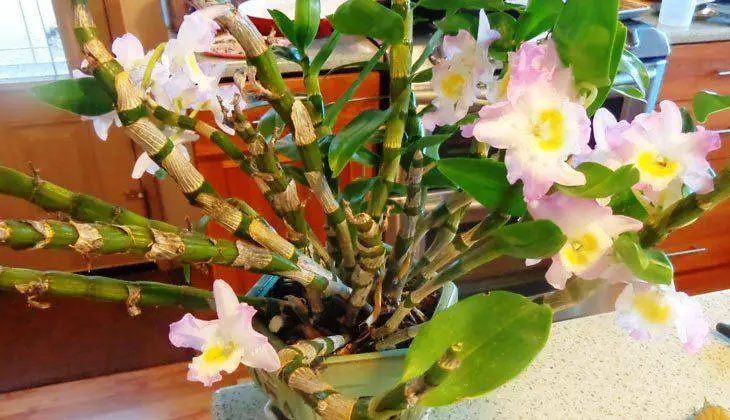Blooming dendrobiums look very impressive. However, this genus of orchids has a pronounced change in development phases, and they need a break between flowering. The material below will tell you how to dendrobium orchid care after flowering and recover faded dendrobiums so that they accumulate enough strength for subsequent flowering.

dendrobium orchid care after flowering
Here all things about how to take care of Dendrobium orchid after flowering.
pruning dendrobium after flowering
The first question that flower growers have to solve in this situation is pruning. After flowering, dendrobiums do not look very decorative. A bare peduncle protrudes from the top of the pseudobulb of the phalaenopsis dendrobium. In Dendrobium Nobile, the pseudobulb stem remains covered with short spent arrows, and the stem itself may begin to dry out and shed leaves.
The decision to prune depends on both the type of dendrobium and the condition of the plant:
| Dendrobium Nobile | Dendrobium phalaenopsis |
| Peduncles that have dropped flowers are not customary to cut off in this type of orchid. Within a few days, the plant will dry them on its own, and there is no need to injure the tissues once again. Pseudobulb stems are also usually not pruned. If they remain green, then after a period of dormancy, flower buds will again grow on them or children will grow. If the pseudobulbs are old and begin to dry out and “go bald”, they are given the opportunity to completely give up the accumulated nutrients to young growing organs. | In this type of orchid, after flowering, the arrow is completely cut off, leaving a “stump” 1.5 cm high.Healthy pseudobulbs of phalaenopsis dendrobiums are not pruned, even if they are already old. |
Recommended for you How to Make Dendrobium Orchid Potting Medium Yourself.
You can cut a pseudobulb only in one case if it is affected by any disease and is a source of infection.
Tip # 1. When growing orchids, one should try to violate the integrity of tissues as rarely as possible. These plants are capable of self-regulation and independently dry out what they no longer need.

dendrobium orchid transplant after flowering
The second issue to be addressed is transplantation. Dendrobiums, like other orchids, are never transplanted during flowering, but after flowering, it can be done.
“I transplant my dendrobiums very rarely and only immediately after flowering. In my experience, this is the most convenient time when orchids hardly notice the transplant. If tightened, they can start to act up and slow down their growth ”.
Dendrobiums do not need a transplant every year. This procedure is relevant only in the following cases:
- the plant has spent more than 2 years in a pot, and the substrate has become rotten, salted or its acidity has increased;
- the plant has grown a lot, and the division of the bush or transplantation into a larger container is required.
In these situations, a planned transplant is carried out immediately after flowering. For this, the necessary materials and tools are prepared in advance:
- new pot (if needed);
- potassium permanganate;
- sharp scissors;
- alcohol;
- ground cinnamon, brilliant green or crushed activated carbon tablets;
- new substrate.
You may also like Methods for dying orchids blue at home.
The orchid is removed from the pot and freed from the old substrate. The transplant pot is washed and disinfected with a potassium permanganate solution. The roots of the dendrobium are examined, all dry or rotten parts are cut off, the cuts are processed with cinnamon, charcoal or brilliant green. If necessary, the bush is divided into parts according to the rhizome.
Next, the plant is placed in a pot, and the roots are covered with a clean, dry substrate. For the next five days, the orchid is not watered so that the cuts and microtrauma on the roots dry out and tighten.
Important! In addition to planned transplants, dendrobiums sometimes require emergency ones – for example, with root decay and other severe infectious processes. In this case, the presence or absence of flowering is ignored and the procedure is carried out as needed.
Air temperature, watering and feeding dendrobium after flowering
If neither pruning nor transplanting is required for dendrobium, care after flowering is reduced to correcting the temperature regime, watering and feeding. The air temperature after flowering should be kept moderately cool – about +20 0 С during the day and about +15 0 С at night. This mode will facilitate the establishment of flower buds.
Feeding of faded dendrobium is carried out regularly, using special complex fertilizers for orchids. The following formulations have proven themselves well:
| Name | Description | Application |
| “Bona Forte for Orchids” | Complete complex with a high potassium content. The NPK ratio is 4: 2.5: 7. Stimulates the growth of vegetative mass and roots, strengthens the immunity of orchids. Contains succinic acid and vitamins. | For root feeding – 5 ml of fertilizer is diluted with 1.5 liters of water.For foliar feeding – 5 ml of fertilizer is diluted with 3 liters of water. |
| “REASIL for orchids” | Complete complex with NPK ratio of 6: 6: 10, supplemented with chelated trace elements, amino acids, vitamins and succinic acid. Ideal for feeding after the orchid has finished blooming. | For root dressing – 1 ml of fertilizer is diluted per 1 liter of water.For foliar dressing – 1 ml of fertilizer is diluted per 2 liters of water. |
| “Pokon for Orchids” | Complete complex with NPK ratio 5: 6: 7. It contains nitrogen in all three forms (amide, nitrate and ammonium), which makes the fertilizer effective for any feeding method. Contains a complex of trace elements necessary at all stages of orchid growth. | For root dressing – 5 ml of fertilizer is diluted per 1 liter of water.For foliar dressing – 5 ml of fertilizer is diluted in 2 liters of water. |
Correction of watering after dendrobium flowering is a very important element of the organization of care. You need to run it like this:
- immediately after the end of flowering, reduce the frequency and abundance of watering, with drying of the substrate;
- adhere to a moderate irrigation regime until the appearance of their own roots in young growth;
- after the formation of roots on young growths, increase watering, but avoiding waterlogging;
- adhere to the increased irrigation regime until the formation of the stop list;
- when pseudobulbs begin to inflate, reduce watering again.
You may also like How To Build An Orchid Greenhouse?
By manipulating temperature and humidity, a large number of flower buds can be set in young growth. Topdressing during this period allows the orchid to receive the necessary elements to build new tissues without depleting its own reserves.
Conclusion
When organizing watering of the dendrobium after flowering, it makes sense to heed the advice of an experienced orchid grower:
“I do not recommend watering a thriving dendrobium by dipping the pot. As long as young growths do not have their roots, immersion can cause them to rot. At this time, it is necessary to water very carefully, with a watering can, along the edge of the pot. Water should not get on the growing buds. Only after the roots have formed on the growths can you start diving again. “